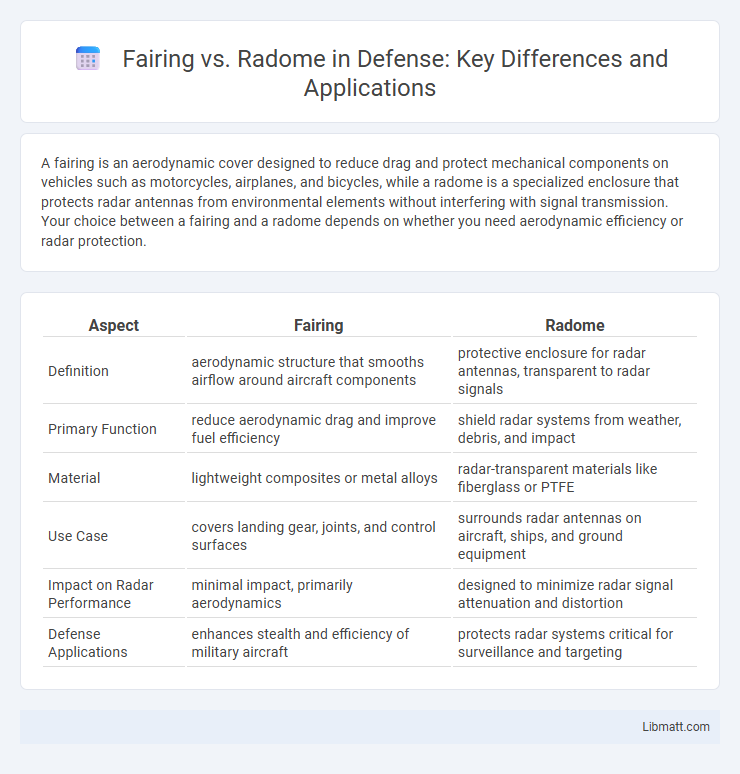A fairing is an aerodynamic cover designed to reduce drag and protect mechanical components on vehicles such as motorcycles, airplanes, and bicycles, while a radome is a specialized enclosure that protects radar antennas from environmental elements without interfering with signal transmission. Your choice between a fairing and a radome depends on whether you need aerodynamic efficiency or radar protection.
Table of Comparison
| Aspect | Fairing | Radome |
|---|---|---|
| Definition | aerodynamic structure that smooths airflow around aircraft components | protective enclosure for radar antennas, transparent to radar signals |
| Primary Function | reduce aerodynamic drag and improve fuel efficiency | shield radar systems from weather, debris, and impact |
| Material | lightweight composites or metal alloys | radar-transparent materials like fiberglass or PTFE |
| Use Case | covers landing gear, joints, and control surfaces | surrounds radar antennas on aircraft, ships, and ground equipment |
| Impact on Radar Performance | minimal impact, primarily aerodynamics | designed to minimize radar signal attenuation and distortion |
| Defense Applications | enhances stealth and efficiency of military aircraft | protects radar systems critical for surveillance and targeting |
Introduction to Fairings and Radomes
Fairings and radomes serve distinct aerodynamic and protective roles in aviation and automotive industries, optimizing vehicle performance by reducing drag and shielding sensitive components. Fairings are streamlined covers designed to smooth airflow over structural parts such as landing gear or joints, enhancing fuel efficiency and stability. Radomes encapsulate radar antennas, protecting them from environmental factors while maintaining signal integrity, ensuring uninterrupted operation of critical navigation and communication systems.
Defining Fairings: Purpose and Function
Fairings are aerodynamic structures designed to reduce drag and protect aircraft components such as landing gear, antennas, or engines by streamlining airflow over protruding parts. Unlike radomes, which specifically house and protect radar systems without influencing aerodynamics significantly, fairings enhance performance by minimizing turbulence and improving fuel efficiency. Your aircraft's fairings play a crucial role in optimizing flight dynamics while safeguarding essential mechanical elements.
Understanding Radomes: Role and Applications
Radomes are structural enclosures that protect radar antennas from environmental elements while minimally interfering with signal transmission, making them essential in aviation, weather monitoring, and military applications. Unlike fairings, which primarily reduce aerodynamic drag on aircraft components, radomes focus on preserving radar functionality and accuracy by maintaining electromagnetic transparency. Their materials and design are carefully selected to optimize radar performance and durability under harsh conditions.
Structural Differences Between Fairings and Radomes
Fairings are aerodynamic covers typically made from composite materials like fiberglass or carbon fiber, designed to reduce drag on aircraft components such as landing gear or antennas. Radomes, on the other hand, are protective enclosures crafted from materials with low electromagnetic interference, like fiberglass or specialized plastics, to shield radar and communication equipment while allowing signal transmission. Understanding these structural differences ensures your aircraft components are both aerodynamically efficient and functionally protected.
Material Comparison: Fairing vs Radome
Fairings are typically constructed from lightweight composites such as fiberglass, carbon fiber, or Kevlar to reduce drag and enhance aerodynamic performance, while radomes are primarily made from specialized dielectric materials like fiberglass or PTFE composites that allow electromagnetic signals to pass through with minimal attenuation. The key difference in material choice lies in their functional requirements; fairing materials prioritize mechanical strength and aerodynamics, whereas radome materials focus on electromagnetic transparency and environmental durability. Advanced radomes incorporate engineered materials with low dielectric constants and loss tangents to maintain radar signal integrity, whereas fairings emphasize high stiffness-to-weight ratios to optimize flight efficiency.
Aerodynamic Impact: Performance Analysis
Fairings and radomes significantly influence the aerodynamic performance of an aircraft by reducing drag and enhancing airflow smoothness around sensitive components. Fairings streamline protruding parts, minimizing turbulence and improving fuel efficiency, while radomes protect radar equipment with minimal aerodynamic penalty due to their specialized composite materials designed for low drag. Your choice between fairing and radome depends on balancing aerodynamic efficiency with the protection and functionality required for onboard systems.
Protection Capabilities: Electronics and Systems
Fairings and radomes both provide essential protection for aircraft electronics and systems, but their design focuses differ. Fairings primarily shield structural components and aerodynamic surfaces from environmental damage, while radomes specifically protect sensitive radar and communication equipment without interfering with signal transmission. Your choice depends on whether the priority is physical protection of external parts or maintaining the functionality of electronic systems under harsh conditions.
Industry Use Cases: Automotive, Aerospace, and Defense
Fairings and radomes serve crucial roles across automotive, aerospace, and defense industries by enhancing aerodynamics and protecting sensitive equipment. In aerospace, fairings streamline aircraft to reduce drag and improve fuel efficiency, while radomes shield radar and communication antennas from environmental damage without signal interference. Your choice between a fairing and radome depends on the specific needs for protection and aerodynamic performance within these high-demand sectors.
Cost and Maintenance Considerations
Fairings generally incur lower initial costs compared to radomes, making them a more budget-friendly option for aerodynamic enhancements. However, fairings may require more frequent inspections and repairs due to their exposure to environmental wear and tear. Your choice should consider long-term maintenance budgets, as radomes, while pricier upfront, offer superior durability and protection, potentially reducing overall upkeep expenses.
Choosing Between Fairing and Radome: Key Factors
Deciding between a fairing and a radome hinges on factors such as aerodynamic efficiency, radar transparency, and environmental protection. Fairings primarily streamline and reduce drag on antennas or sensors, optimizing performance in high-speed applications, while radomes safeguard sensitive equipment from weather without significantly impacting electromagnetic signals. Selecting the appropriate solution depends on balancing protection needs with signal integrity and aerodynamic requirements in aerospace, marine, or automotive contexts.
fairing vs radome Infographic

 libmatt.com
libmatt.com